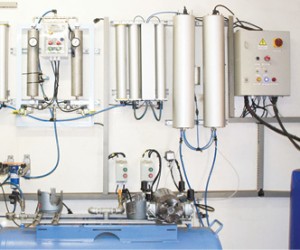The quality of water available for human consumption is deteriorating worldwide. Levels of microbiological contamination in water bodies show an increasing trend, while bacterial species are becoming more resistant to conventional halogen based disinfectants.
Highly resistant virus strains occur and reports of such diverse microbiological pathogens appear with ever increasing frequency. Conventional disinfection by means of chlorine is no longer a guaranteed barrier against waterborne transmission of diseases.
Industrial, agricultural and mining operations pollute water bodies with a variety of organic and inorganic chemicals. Many of these chemicals are known to be carcinogenic (cancer causing), while others are responsible for a number of ailments through chronic exposure.
Sewage effluent, both treated and untreated, is a major contributor to the pollutant levels of water bodies, and also causes the generation of secondary pollutants through algae growth in eutrophic water bodies. Algae toxins and secretions are formed, creating not only unacceptable taste and odours in the water, but also chemical compounds toxic to man.
Faced with these facts, water treatment facilities are forced to stretch conventional purification methods beyond the limit of effectiveness, or abuse the application of chlorine in an attempt to address all the problems. This leads to the secondary pollution by chlorine and its derivatives, also registered carcinogens.
Ozone as an environmentally friendly solution
Ozone is a vastly superior disinfectant to chlorine, disinfecting around ten times more effectively and remains the only real option to deactivate certain resistant viral strains, as well as parasitic species. (Giardia and Cryptosporidium). A number of ozone plants exist specifically for deactivation of these two species, where chlorine was shown to be ineffective. Ozone is a powerful oxidiser, which means that it will destroy many chemical molecules, or change them to more benign forms to enable safe discharge of water.
Internationally, a vast number of water treatment facilities utilize ozone as the next generation water treatment option. They are : Montreal, Paris, Singapore, Brussels, Helsinki, Zurich, Los Angeles, New York, Moscow and others.
Although ozone technology has been around for a long time and is globally practised, it is a relatively new technology in South Africa.
In South Africa, large-scale ozonisation is only used at Wiggins Water Works in Umgeni, Midvaal Water Company in Stilfontein, Magalies Water Treatment Works and Delmas Water.
The high price of imported ozonisation equipment, inadequate local technical support and the large scale on which ozone must be deployed in large quantities of water, has to date prohibited its installation at central water treatment plants in South Africa.
History:
Ozone Aqua was established in 2000, and is headquartered in Hartbeespoort, North West Province, with presence in Mpumalanga and Gauteng.
Ozone Aqua is a South African leader in the development of ozone technologies for residential, commercial and industrial markets with a focus on drinking water treatment, chemical pollutant removal, wastewater treatment and water reuse.
Ozone Aqua offers a large portfolio of locally designed, manufactured and maintained solutions according to
customer-specific requirements.
Through highly qualified and experienced teams, we combine the core competencies of ozone technology development and system engineering as an integral solution to water challenges in South Africa.
Our services include scalable and modular ozone plant configuration and customer-specific operating and maintenance models. We use locally developed proprietary
technology and also offer pay-per-use water treatment models with minimal life cycle cost, as well as reduced carbon and water footprint.






